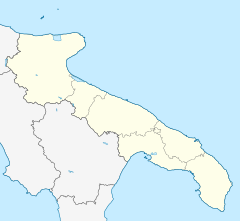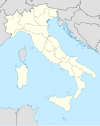User:Mm4reea/Saint Eustace's co-cathedral
| Saint Eustace's co-cathedral | |
|---|---|
Concattedrale di Sant'Eustachio | |
 Facade | |
| Religion | |
| Affiliation | Roman Catholic Church |
| Province | Diocese of Altamura-Gravina-Acquaviva delle Fonti |
| Ecclesiastical or organizational status | co-cathedral |
| Year consecrated | 1623 |
| Status | active |
| Location | |
| Municipality | Acquaviva delle Fonti |
| State | |
| Geographic coordinates | 40°53′48″N 16°50′30″E / 40.8967°N 16.8417°E |
| Architecture | |
| Style | romanesque, renaissance |
| Groundbreaking | 1158 |
| Completed | 1594 |

The co-cathedral of Saint Eustace is the main church of Acquaviva delle Fonti. The dedication is to Saint Eustace. It is now a co-cathedral of the Diocese of Altamura-Gravina-Acquaviva delle Fonti.[1] Previously it was the palatine church of Acquaviva delle Fonti, which became part of the territorial prelature of Altamura e Acquaviva delle Fonti formed by Pius IX in 1848, when he added Acquaviva to the existing territorial prelature of Altamura.
History[edit]
Built in Romanesque style in the XII century (1158) on the ruins of a small temple that has Messapian origins by the will of the Norman feudal lord Roberto Gurguglione, it was rebuilt in a rennaissance style in the XVI century. The church was originally dedicated to the Assumption of the Virgin Mary and only later was entitled to the name of the martyr Saint Eustace.
The primitive church, now run down and insufficient for the needs of the increased population, was rebuilt form 1529, when Giovanni Antonio Donato Acquaviva was the feudal lord of Acquaviva. Finished and opened to the worship in 1594 during the government of Alberto Acquaviva, the church was consecrated in 1623 in honor of Saint Eustace by the archibishop of Bari in Canosa Ascanio Gesualdo.
Since the beginning it was called "palatina", that belongs to the king (from the latin word palatium that means "royal palace"), probably to preserve it from the aims of the Bari's archbishop. The palatine churches for their jurisdiction didn't depended on the ordinary ecclesiastical authority, but from the king, who usually called and remunerated clerics chosen by him[2]. Currently on the Apulian ground there are four: the cathedral in question of Acquaviva, Saint Assumed Mary's cathedral in Altamura, Saint Nicholas' in Bari and the Saint Michael's sanctuary in Monte Sant'Angelo[3].
On the 13th January 1859, after a stop in Acquaviva passing by Bari for the marriage of the hereditary prince with Maria Sofia of Baviera, the penultimate king of the Kingdom of the two Sicilies Ferdinand II attends the plain mass in the crypt of the cathedral.[4]
Description[edit]
Exterior[edit]
The main facade has a cusp, tripartide by pilasters and divided in two orders (the first one is corinthian, the second doric), all is in a Renaissance style, while the rest of the facades have an architectural style that recalls the Apulian Romanesque.
A Reinassace rose window opens in the center of the frontal prospect, that tends to manierism, formed by sixteen columns placed like rays and connected by little arches. Under these there is an alternation of valves made with shells and heads of winged puttini. From the center of the rose window protrude a phytomorphic lithic figure.
The main portal has a protiro finely decorated. The columns that support their pediment rest on two stylophores lions.
The lateral portals are dominated by two niches that are nowadays empty. Each of them have installed on the top a bas-relief that shows an antic version of Acquaviva delle Fonti coat of arms.
The archivolt of this portal has a bas-relief that represents Saint Eustace's conversion.[5]
The facade ends on the top with a broad triangular fifth, in which center there is a plaque commemorating the name of the feudal lord of Alberto Acquaviva. On the three vertices there are sculptures made of stone, that represent Saint Peter and Saint Paul on the sides and Virgin Mary sit with his Child on the knees on the central one.
Interior[edit]
The interior, with a latin cross floor, is divided in three naves with vaulted roof. The main vault is supported by large arches, which rest on stone pillars with columns half overhang in the direction of the aforementioned arches. The perimeters walls have half extended columns, surmounted by fake little pillars supporting the arches. The vaults, as well as the pillars and columns, are decorated with stuccoes. The high altar, dating back to the 16th century, is dedicated to the Virgin of Constantinople. The oil paintings, which adorned the primitive church, were donated to the churches of Saint Dominick, Saint Mary the Greatest, Sant'Agostino and Santa Maria della Libera during the reconstruction works. The monumental organ was donated to the church by Bishop Tommaso Cirielli.[6]
Crypt[edit]
The crypt, probably built at the same time of the primitive church, has a parallelogram shape and is covered by twenty-four cross vault, supported by fourteen marble columns of ionic order in the center and by little pillars protruding from the perimeter walls. Leaning against the rear wall there are three valuable altars. On the first of them is placed a picture of Saint Eustace, on the sides of which two marble sculptures rest on shelves, representing respectively the wife of the saint, Theopista, and the group of sons Teopisto and Agapio.
The central altar, built in 1693 and dedicated to the Blessed Sacrament, it is surrounded by French breach balustrades. The frontal, all in double silver sheet, has an octagonal temple surmounted by a small dome and divided into three floors decorated with various figures. A large tabernacle stands out on the altar.
The third altar, built in 1753 and dedicated to the Virgin of Constantinople, is entirely covered with silver sheets. Over it dominates a painting attributed to Francesco Palvisino depicting the aforementioned Madonna that holds the Child in her arms. The images of the Madonna and the Child are adorned with two golden crowns.

On the choir in the counter façade there is the pipe organ, built in 1905 by Carlo Vegezzi Bossi; the instrument, over time, has undergone major restorations and renovations, including that of 1968, conducted by Leonardo Consoli, and that of 2001-2004 conducted by the organ building firm Continiello, during which, among other things,the wooden box, the work of the acquavivese Paolo Tritto, was removed and was supplied the new mobile console.
The instrument, with electric transmission, has three keyboards of 58 notes each and a concave-radial pedal of 30. Below, its phonic arrangement[7]:
|
|
|
| ||||||||||||||||||||||||||||||||||||||||||||||||||||||||||||||||||||||||||||||||||||||||||||||||
Notes[edit]
- ^ "Tutte le parrocchie". Parrocchia Santa Maria Maggiore.
- ^ "Le Parrocchie | Diocesi di Altamura-Gravina-Acquaviva d. Fonti". Diocesi di Altamura-Gravina-Acquaviva d. Fonti (in Italian). Retrieved 2017-03-15.
- ^ "La Cattedrale – Cattedrale" (in Italian). Retrieved 2020-08-25.
- ^ "Cronistoria di Acquaviva, dall'anno 1800 all'anno 1900". Cassarmonica.it.
- ^ "Cattedrale". Pro Loco Acquaviva.
- ^ "Don Mimmo Giannuzzi, parroco Concattedrale di Sant'Eustachio, Acquaviva delle Fonti – Bari | Siamo Noi". www.tv2000.it (in Italian). Retrieved 2017-03-15.
- ^ "L'organo della Chiesa Cattedrale". Organi Baresi.
External links[edit]
- "Official website" (in Italian).
{{cite web}}: CS1 maint: url-status (link)
40°53′48″N 16°50′30″E / 40.8967°N 16.8417°E
Category:Roman Catholic cathedrals in Italy Category:Cathedrals in Apulia Category:Churches in the metropolitan city of Bari Category:Buildings and structures in the Province of Bari Category:Renaissance architecture in Apulia Category:Roman Catholic churches completed in 1594 Category:16th-century Roman Catholic church buildings in Italy




